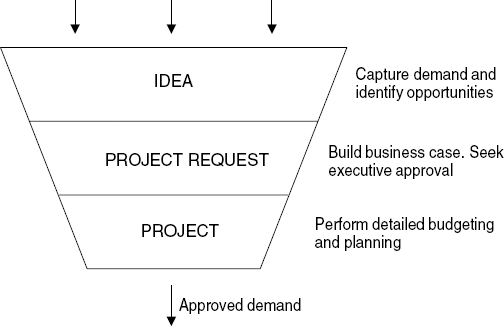4.2. Managing demand – new model
Using the fundamental premise that not all demand from the business will be approved, because of business priorities on the one hand, and IT resource and scheduling constraints on the other, the best way of representing demand would be via a funnel, as shown in Figure 4.1. Demand from the business enters at the top, follows one or more decision-making processes, and then either exits at the bottom as approved work to be executed, or remains in the pipeline pending further evaluation.
Figure 4.1. Managing demand (pipeline approach)

The first stage (or gate, or stage gate) of the funnel represents 'ideas' or opportunities, which comprise only high-level information and estimates for timescales, costs and benefits. Ideas generally represent work intake that IT has not yet had the chance to evaluate in detail, but which needs to be acknowledged as having entered the pipeline.
As part of a filtering and screening process, these ideas then move down to the next stage, called 'project requests', during which they are further qualified with quantifiable cost and benefit information, to a level of detail which makes high-level planning and a cost-benefit analysis possible. It is during this stage that the business case is built for executive sponsorship and approval.
Finally, once the business case has been approved, the project request moves down to the ...
Get IT Success!: Towards a New Model for Information Technology now with the O’Reilly learning platform.
O’Reilly members experience books, live events, courses curated by job role, and more from O’Reilly and nearly 200 top publishers.

